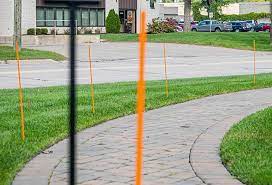Fiberglass marking is a versatile and durable method for creating visible and long-lasting markings on various surfaces. Whether you’re a novice or an experienced professional, understanding the nuances of fiberglass marking is crucial. This guide will take you through the essentials, ensuring you’re well-equipped to embark on successful fiberglass marking projects.

fiberglass marking
Introduction
What is Fiberglass Marking? Fiberglass marking involves the application of markings on surfaces using fiberglass-based materials. This method is preferred for its durability and clarity, making it suitable for a wide range of applications.
Benefits of Fiberglass Marking
Durability and Longevity
Fiberglass marking stands out for its remarkable durability, ensuring that markings withstand the test of time. This longevity is especially valuable in high-traffic areas where conventional markings may wear off quickly.
Visibility and Clarity
One of the key advantages of fiberglass marking is its exceptional visibility and clarity. This makes it an ideal choice for scenarios where clear and unmistakable markings are crucial, enhancing safety and organization.
Types of Fiberglass Marking
Embedded Fiberglass Marking
This type involves embedding fiberglass materials directly into the surface, creating a robust and long-lasting marking. It is commonly used in industrial settings and roadways.
Surface Application
Surface application is a simpler method where fiberglass-based paint or materials are applied directly to the surface. This is a versatile option suitable for a variety of surfaces.
Choosing the Right Fiberglass Marking
Consideration of Environment
When selecting fiberglass marking materials, it’s essential to consider the environment. Factors such as weather conditions, temperature variations, and exposure to chemicals can impact the effectiveness of the marking.
Compliance with Regulations
Ensure that your fiberglass marking adheres to relevant regulations and standards. Compliance is critical, especially in industries where safety markings are subject to specific guidelines.
Preparation for Fiberglass Marking
Surface Cleaning and Priming
Before applying fiberglass markings, thorough surface cleaning and priming are essential. This ensures proper adhesion and longevity of the markings.
Safety Precautions
Adhering to safety protocols during the preparation phase is crucial. This includes using protective gear and working in well-ventilated areas.
Application Techniques
Spray Method
The spray method is a popular choice for large surface areas. It provides a quick and even application, ideal for projects with time constraints.
Roll-On Application
For precise markings and smaller projects, the roll-on application technique offers control and accuracy. It’s a preferred method for intricate designs and detailed markings.
Curing and Drying Process
Timeframe
Understanding the curing and drying process is vital. Different fiberglass marking materials have varying timeframes for complete curing. Follow manufacturer guidelines for optimal results.
Environmental Factors
Environmental conditions, such as temperature and humidity, can influence the curing process. Ensure ideal conditions for the markings to set correctly.
Common Mistakes to Avoid
Inadequate Surface Preparation
Skipping or inadequately performing surface preparation can compromise the adhesion of fiberglass markings. Invest time in preparing the surface adequately.
Using Incorrect Marking Material
Using the wrong fiberglass marking material for a specific surface or environment can lead to premature wear and reduced effectiveness. Choose materials based on project requirements.
Maintenance Tips
Regular Inspection
Periodic inspections of fiberglass markings are essential. Address any signs of wear or damage promptly to maintain optimal visibility and safety.
Quick Repairs
In the event of damage, swift repairs are crucial. Having a contingency plan for quick fixes ensures uninterrupted functionality of markings.
Fiberglass Marking: The Ultimate Guide for Beginners
Importance for Beginners
For beginners, fiberglass marking opens up a world of possibilities in creating clear and durable markings. The simplicity of application and the lasting impact of fiberglass markings make it an ideal starting point for those new to the field.
Step-by-Step Guide
1. Surface Preparation:
Begin by thoroughly cleaning and priming the surface to ensure proper adhesion.
2. Material Selection:
Choose the right fiberglass marking material based on the environment and surface type.
3. Application Technique:
Select a suitable application technique, whether spray or roll-on, based on the project requirements.
4. Curing and Drying:
Follow the recommended timeframe and environmental conditions for the curing and drying process.
5. Regular Maintenance:
Conduct regular inspections and address any issues promptly to extend the lifespan of fiberglass markings.
Environmental Impact
Eco-Friendly Options
Fiberglass marking offers eco-friendly options, with some materials designed to minimize environmental impact. Consider these options for sustainable projects.
Sustainability Considerations
Incorporate sustainability into your fiberglass marking projects by choosing materials with minimal ecological impact. This aligns with the growing emphasis on environmentally conscious practices.
FAQs
- How long does fiberglass marking last? Fiberglass markings can last for several years, depending on factors such as traffic, weather, and surface type.
- Can it be applied on any surface? While fiberglass marking is versatile, it’s essential to choose the right material for specific surfaces, considering factors like porosity and texture.
- Is fiberglass marking suitable for outdoor use? Yes, fiberglass marking is suitable for outdoor use. However, selecting weather-resistant materials is crucial for long-term effectiveness.
- What is the average cost of fiberglass marking? Costs vary based on material and project size. On average, fiberglass marking is cost-effective due to its longevity.
- How can one remove fiberglass marking if needed? Removal methods depend on the material used. Mechanical methods or specialized solvents are common options.
- Are there different color options available? Yes, fiberglass marking materials come in various colors, allowing customization based on project requirements.
Conclusion
In conclusion, mastering fiberglass marking is a valuable skill for both beginners and seasoned professionals. This guide has covered essential aspects, from material selection to application techniques, ensuring you’re well-equipped to embark on successful projects. Remember, the durability and visibility of fiberglass markings make them a reliable choice for a wide range of applications.
 info@unicomposite.com
info@unicomposite.com


























